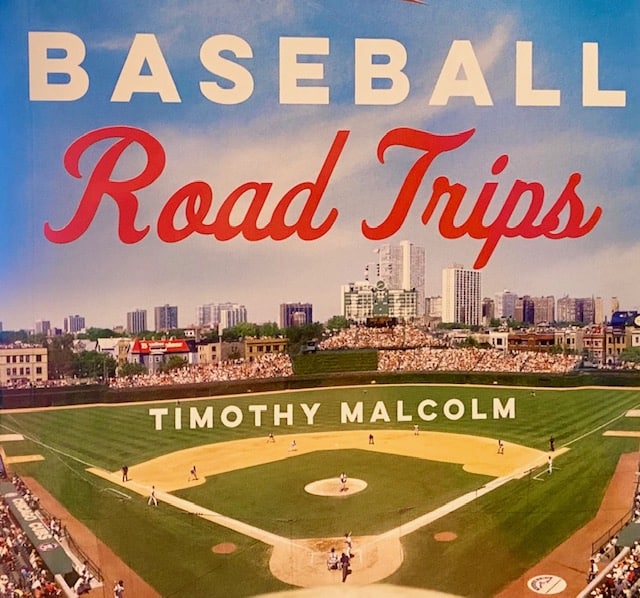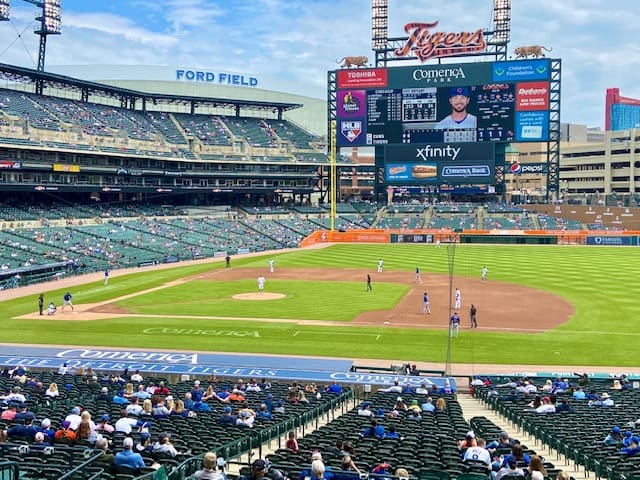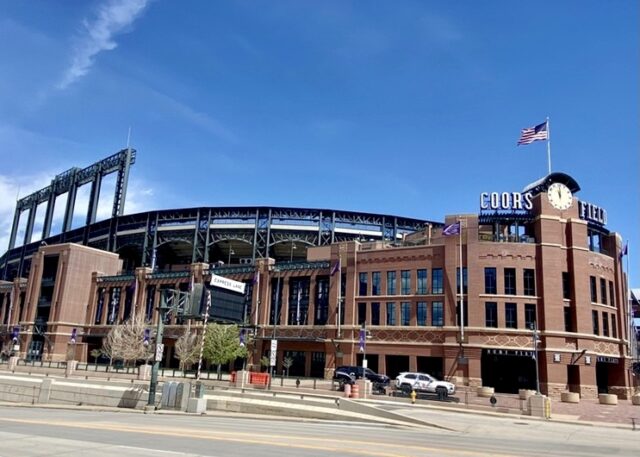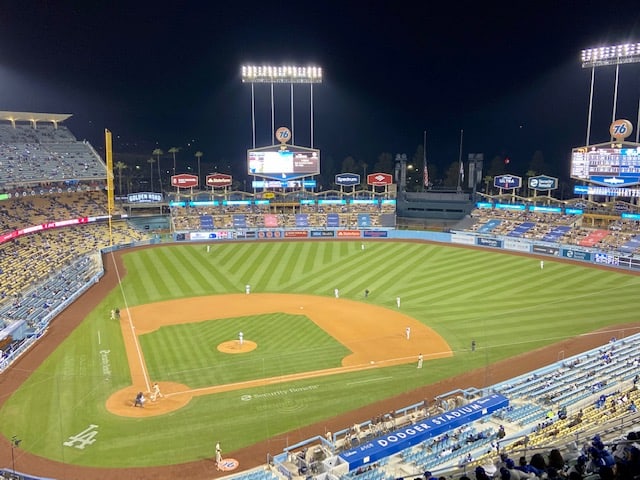

“I don’t know if Wrigley is the best of all the ballparks. I would say the ballpark in San Francisco is over all the best but Wrigley is so iconic.” – Timothy Malcolm, author
I have been doing a little baserunning myself these days, pardon the pun, and my travels have involved visits, pastime pilgrimages if you will, to acres of diamonds in baseball parks across America.
There’s something about the sight of a ballpark that provides a feeling of centering when visiting a town. Whether a game is going or not it’s exciting to catch a glimpse of venues such as Camden Yards, Yankee Stadium or Marlins Park in a cab, car, or on foot in Baltimore, New York or Miami, respectively.
The very presence of a Major League Baseball team with names like the Giants, Padres, or Royals gives a city credibility and special status. Even minor league ballparks and their teams with typically more whimsical nicknames – Pit Spitters, Beach Bums, Loons, Lugnuts and Whitecaps are some that come to mind (each of which happen to be in Michigan) provide civic color and charm.
Greenville, South Carolina has the best of both worlds. Its downtown minor league stadium, Fluor Field, is modeled to look like a mini-Fenway Park, complete with a “Green Monster” left field wall, since it is home to the Greenville Drive, an affiliate team of the Boston Red Sox.
Baseball Road Trips
Timothy Malcolm authored the book Baseball Road Trips – the Complete Guide to All the Ballparks, with Beer, Bites and Sights Nearby. He had the misfortune of seeing his first baseball game as a kid when the Phillies played on the day-glow Astroturf in Philadelphia’s cavernous, charmless, multi-purpose Veterans Stadium.
“Overall it was very boring,” he admitted.
Malcolm opted to put Chicago’s Wrigley Field on the cover of his book.
“I don’t know if Wrigley is the best of all the ballparks. I would say the ballpark in San Francisco is over all the best but Wrigley is so iconic. It just makes sense. It catches people’s eye,” he explained. Wrigley Field is known as the “Friendly Confines.” “Wrigley Field’s got the ivy growing in the outfield and the manually operated scoreboard and the Wrigleyville area around the park with all the bars for the pre and post game scene.”
Wrigleyville is worth a visit whether the Cubs are playing or not. The tastefully themed Hotel Zachary – named for Zachary Taylor Davis, the architect of Wrigley Field – is the most immersive and, just across the street, is a timeless, elegant extension of the ballpark while offering unique views of Wrigley in any season.
Detroit’s Tiger Stadium was an antique like Wrigley Field but was torn down and replaced by a new ballpark a mile or so away. “It will never match the nostalgia of Tiger Stadium and the nostalgia that park had but it’s certainly an upgrade in regard to amenities and cleanliness. It’s a sparkling park Detroiters can celebrate because it’s in an accessible location that helped revitalize the city,” Malcolm insisted. “I love the fact the stadium celebrates the Detroit Coney Dog scene with food options in the new park. And actual Tigers are sprinkled all around the park and it can be like a treasure hunt to find all of them.”

The giant tigers out front, the ones lurking above the massive scoreboard screen, and the merry-go-round full of them are my favorites, though I admit longing for the days when I’d emerge from the damp, dark, tunnel-like concourse up the narrow passageways and into the sunlit center of the old Tiger Stadium with its obstructed-view seats and, conversely, upper deck seats that literally extended out over the playing field.

Vertigo Deep in the Heart of Texas
I climbed to the top of the Houston Astros ballpark during an early season night game against the visiting Tigers and it, too, was a vertigo-inducing experience. The seats in the upper deck are stacked steeply and sitting up there was like summiting the stadium.
“It is a very steep park,” Malcolm admitted when I described my left-field perch experience. “There is a guy named Bobby Dynamite up in left field I feel sorry for. There is an actual old, refurbished train up there in the park and it rolls along the track anytime the Astros hit a homerun or win a game and really loud fireworks go off. He wears overalls and operates the train from a very high perch. I asked Dynamite if he was scared up there and while he admitted he’s afraid of heights he insisted he loves it up there.”
Malcolm described the Astros ballpark as “kooky.” “It feels like a baseball stadium but it’s also like a big amusement park. I think that is kind of fitting for Houston.”
I told Malcolm I enjoyed the amusement park-type food offered there. I noticed, under heat lamps, Cheetos-flavored popcorn and personally enjoyed a heart-stopping triumph: the footlong chili cheese corn dog.
The first time I heard them sing that song, I realized how important Texas Pride was. Wow – I understand why people love this place so much.

I found Houston, downtown and otherwise, to be much more enjoyable and pleasant than expected. From a distance one sees the industrial sprawl of the lifeblood of Texas – the oil industry. But the parks, greenspaces, restaurants and neighborhoods are as pleasant as can be – albeit exceedingly humid and hot in the summertime.
Cool your jets at the leafy oasis that is The Houstonian Hotel, the four-star, low-rise, modern-yet-stately resort about 15 minutes from the ballpark that feels more like a “Texas-chic” club than a hotel. $23-million in recent renovations make the hotel, with its’ floor-to-ceiling guest room windows, completely comfortable and modern. Those windows look through the trees over a shaded trail that serves as a walking track around the 27-acre property and its’ 175-000 square-foot luxury health club and fitness facility and adjacent spa. There are three outdoor swimming pools – a 25-meter sports pool for lap swimming; a Garden Pool for serenity and soaking; and for cavorting the resort pool presents a pleasant waterfall and natural slide for children.
Many hotels offer event space but not many can say they hosted world leaders for a G7 Summit Meeting and treaty signing. The Houstonian can because both its Manor House and hotel suite #271 served as Houston homes to U.S. President and First Lady George and Barbara Bush at various times in their lives.
George Bush, who played first base at Yale University, loved baseball and attended Astros games even on the occasions when he wasn’t throwing out the first pitch.
“The President took me to many baseball games in Houston and tried so hard to convert me to be an Astros fan but he couldn’t do it. I remained loyal to my St. Louis Cardinals. It was probably the only diplomatic effort in his career he could not achieve,” said Jean Becker, who served both the President and First Lady in various professional capacities throughout her career and led to her living in Houston. She writes about the experiences as his chief of staff in her book The Man I Knew – the Amazing Story of George H.W. Bush’s Post-Presidency.
The Bushes also loved Brennan’s of Houston, the iconic steakhouse run since 1983 by Alex Brennen-Martin that is not only Houston’s best but one of America’s most popular. “Houston’s become my adopted hometown and I just love it. As for President Bush he loved chili-fried oysters over a roasted corn sauce,” said Brennan-Martin. “We haven’t had that on the menu for years but when he was coming in we knew to prepare it. I’m not sure he knew that, though, because he was one of the more humble people I’ve ever met.”
Brennan’s and the Houstonian, were “hits” with baseball-loving Bush, pardon the pun.
Downtown Denver’s Diamond
While the climb to the top of the Astros ballpark seemed like summiting a mountain, the actual Rocky Mountains are in view from the Colorado Rockies ballpark in Denver even though it is right smack in the downtown area of the ever-growing Mile High City.
In fact, the National Ballpark Museum is actually situated across the street from Coors Field near a hopping (again, pardon the pun) part of town called the River North Art District (RiNo) known for America’s largest concentration of craft breweries and stunning, colorful murals (which I suppose become even more colorful the more you consume at establishments such as Epic Brewing and Odell Brewing.)
Read More in our Denver Travel Guide.

Ed Sealover, a Denver journalist, wrote Colorado Excursions with History, Hikes and Hops. “Historic sites, natural sites and drinking sites are the three best attributes of Colorado and people should dive into all of them,” he said with a glass of suds in hand at Ratio Beerworks, the microbrewery.
John Deffenbaugh, a Scotsman who moved to Denver to become projects director of the RiNo Business District was clearly qualified to offer valuable travel advice: explore beyond the Rockies first-base line. “See the neighborhoods when you come to Denver. RiNo straddles five historic neighborhoods.”
Sealover and I twisted his arm to have a glass of Ratio’s Hold Steady, a chocolate rye scotch ale in a Belgian frosted glass.
Soak up the suds by walking the murals and build a base beforehand by eating at Posto, the snazzy Italian eatery attached to Denver Central Market – the bustling hub of the RiNo District featuring 11 top chefs and food purveyors.
Luca, an authentic gourmet Italian experience of the other side of town will serve you a dinner that will make you swear off ballpark food forever. Skip the hotdogs and save your calories for Luca’s jumbo lump crab ravioli with goat cheese; braised short rib; and other rich, delicate dishes.
The best eye candy in town is the new Crawford Hotel. It’s gorgeous and just a few blocks from the ballpark. Baseball loves to honor its past and create modern parks which maintain an old-time feel of nostalgia, and that’s exactly what The Crawford has done…in the train station!
“Denver Union Station opened in 1881 and in 2014 we turned it into a hotel,” said general manager Ed Blair, who also literally makes the trains run on time. “We thought about the romance of traveling by train and spent $54 million to return this great hall into its Hollywood-feeling glory. We took modern luxury and blended it into that history,” said Blair from the brassy, 1920’s-style Cooper Lounge overlooking the hall. “You get a piece of history, 14 different food outlets, and you get to experience something different.”
Denver has embraced the indoor and outdoor settings as The Crawford and Union Station have become a destination for those taking trains and locals.
La La Land’s Dodger Stadium
Dodger Stadium, which opened in Los Angeles 1962, is the oldest ballpark west of the Mississippi and the third oldest in America behind Wrigley and Fenway is Dodger Stadium (which makes it, by comparison, still a relative newcomer.) While watching the game and taking in a glimpse of the downtown L.A. skyline or San Gabriel Mountains you definitely do not want to skip the hotdogs. Signs throughout the stadium tout the “Dodger Dogs,” one of which I even stuffed into my coat pocket for my drive back to the Beverly Hilton Hotel. The Dodger Dog, a 10-inch pork wiener on a steamed bun is the Major League’s best-selling treat. The grilled version, available throughout the stadium, is considered the traditional classic.

Whether the Dodger Dog would taste as good in a blind tasting in a different setting I cannot say for sure.
There is something to a “sense of place and tradition” which is also part of the reason why I stay at the Beverly Hilton when I am in Los Angeles. Conrad Hilton opened it in 1955 and has been making Hollywood news ever since. The Beverly Hilton’s location at the intersection of Santa Monica and Wilshire Boulevards puts it in the center of the La La Land and Beverly Hills action that business leaders, celebrities and major politicians have always found irresistible. The hotel is as exciting as baseball’s triple play – a variation of which the Hollywood Reporter says JFK may have once tried to arrange at the Beverly Hilton. Talk about an intersection!
Dodger Stadium also sits in a unique setting: it’s literally built on various levels into the Chavez Ravine.
“Dodger Stadium is gorgeous,” said Malcolm. “It’s one of those quintessential places where if you want to see what a baseball game is really like you should go. They’ve really upgraded it, too.”
I enjoyed the wide outdoor spaces and ability to stroll throughout the stadium for varying views and the “smallness” of a big-time park. Elevators and escalators moved people around between the souvenir stands and concession windows. With museums and memorabilia and vista and venues – with plenty of nods to history such as a Jackie Robinson statue and the Vin Scully press box – Dodger Stadium is naturally and purposely glamorous.

Read more of Michael Patrick’s work at The Travel Tattler, or contact him at [email protected]
- e.baldi is Beverly Hills Best Italian Dining Delicacy - April 23, 2024
- Ashford Castle Hotel, U2’s Bono and Why Visting Ireland is So Entertaining - March 28, 2024
- Solo Travel to Oceania Cruise Ports St. Barth’s and Barbados Became Authentic Cultural Encounters - February 27, 2024
